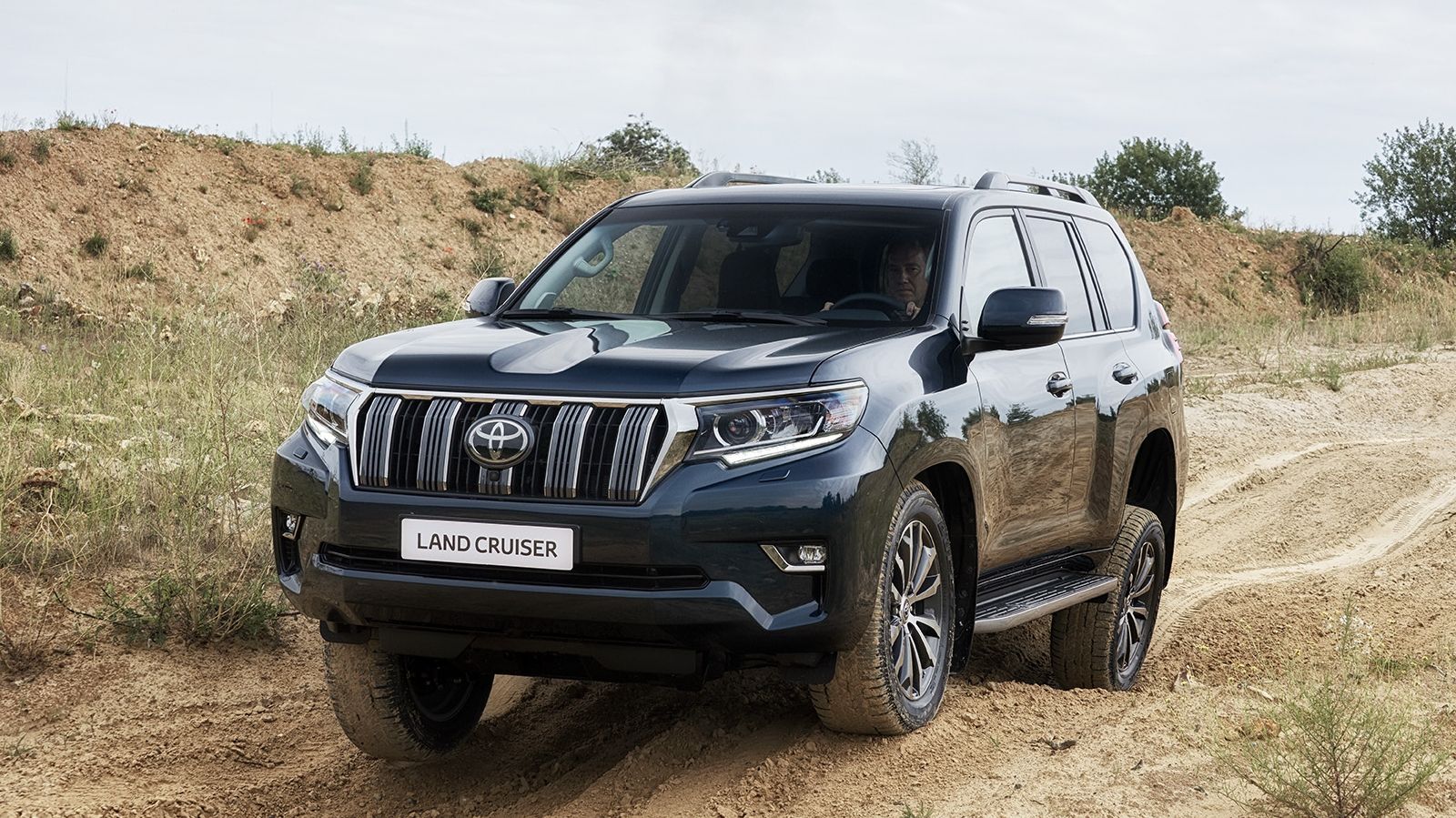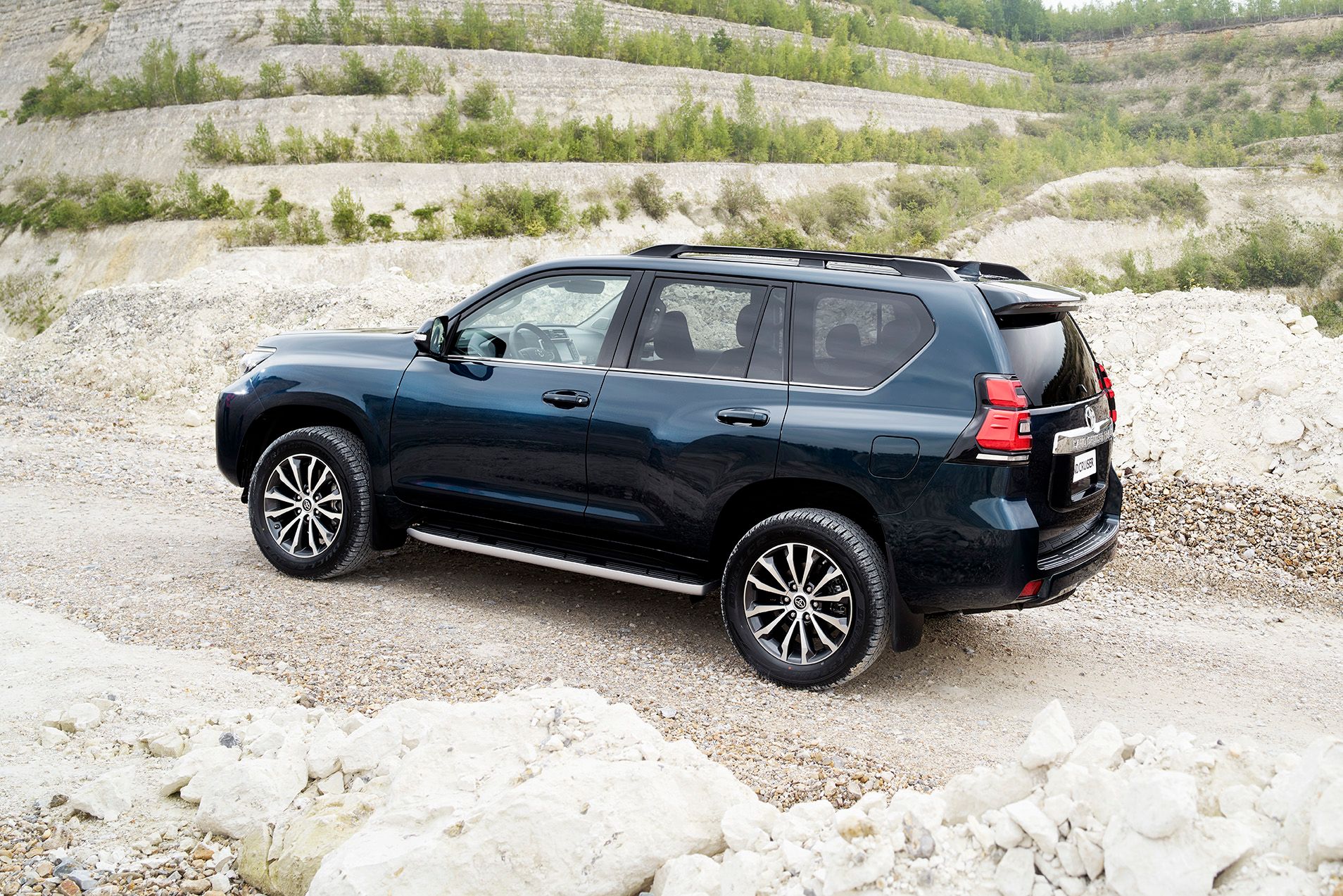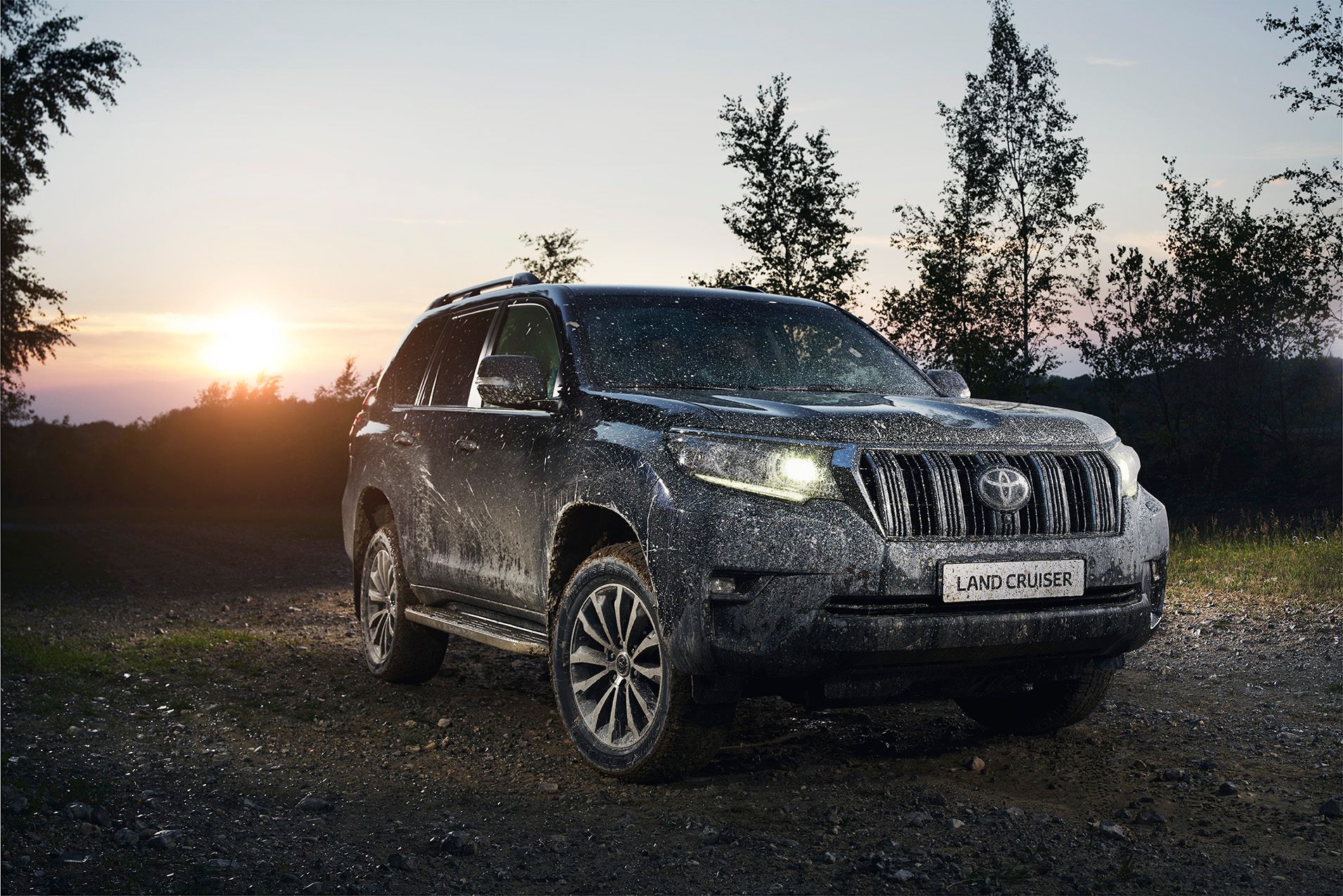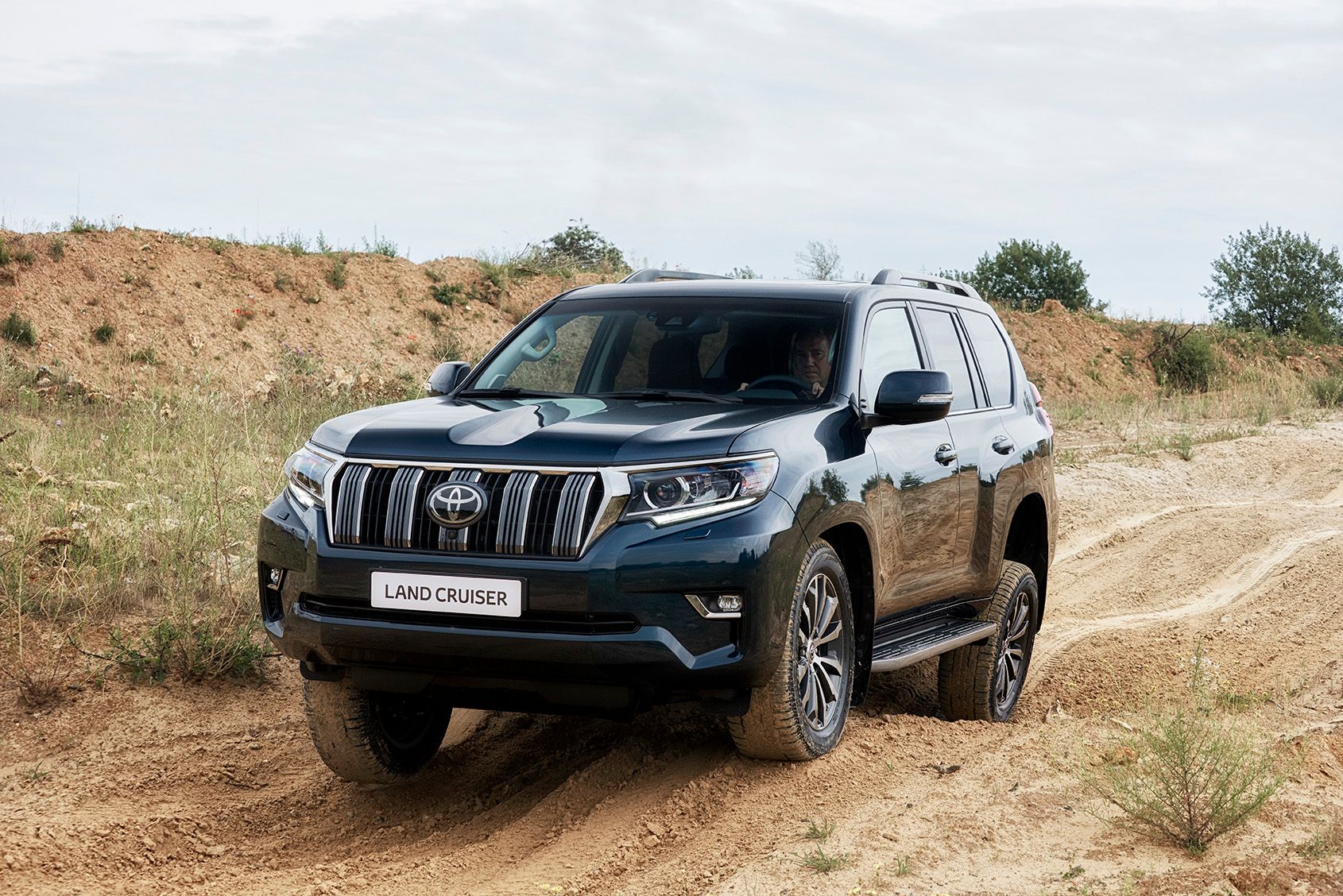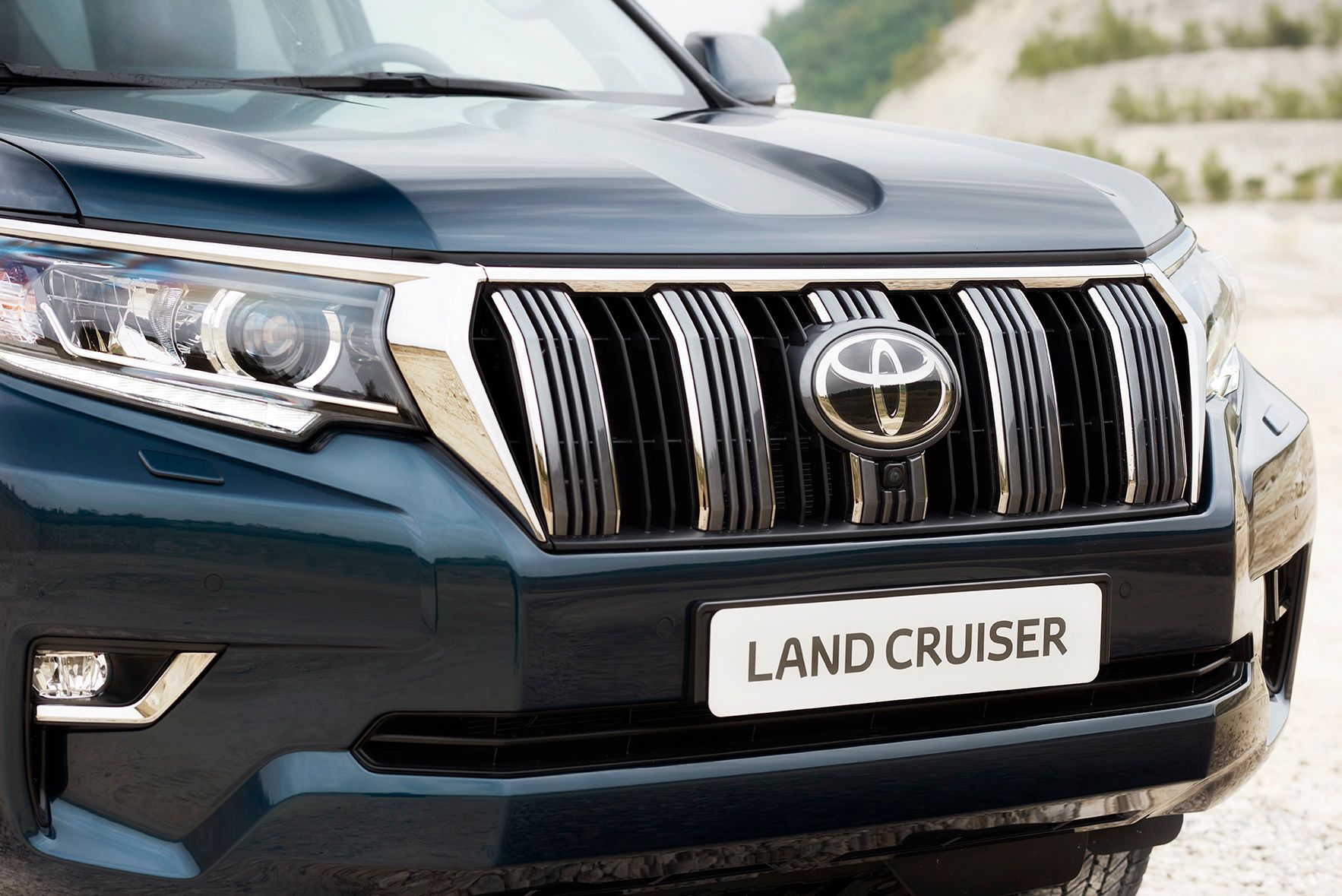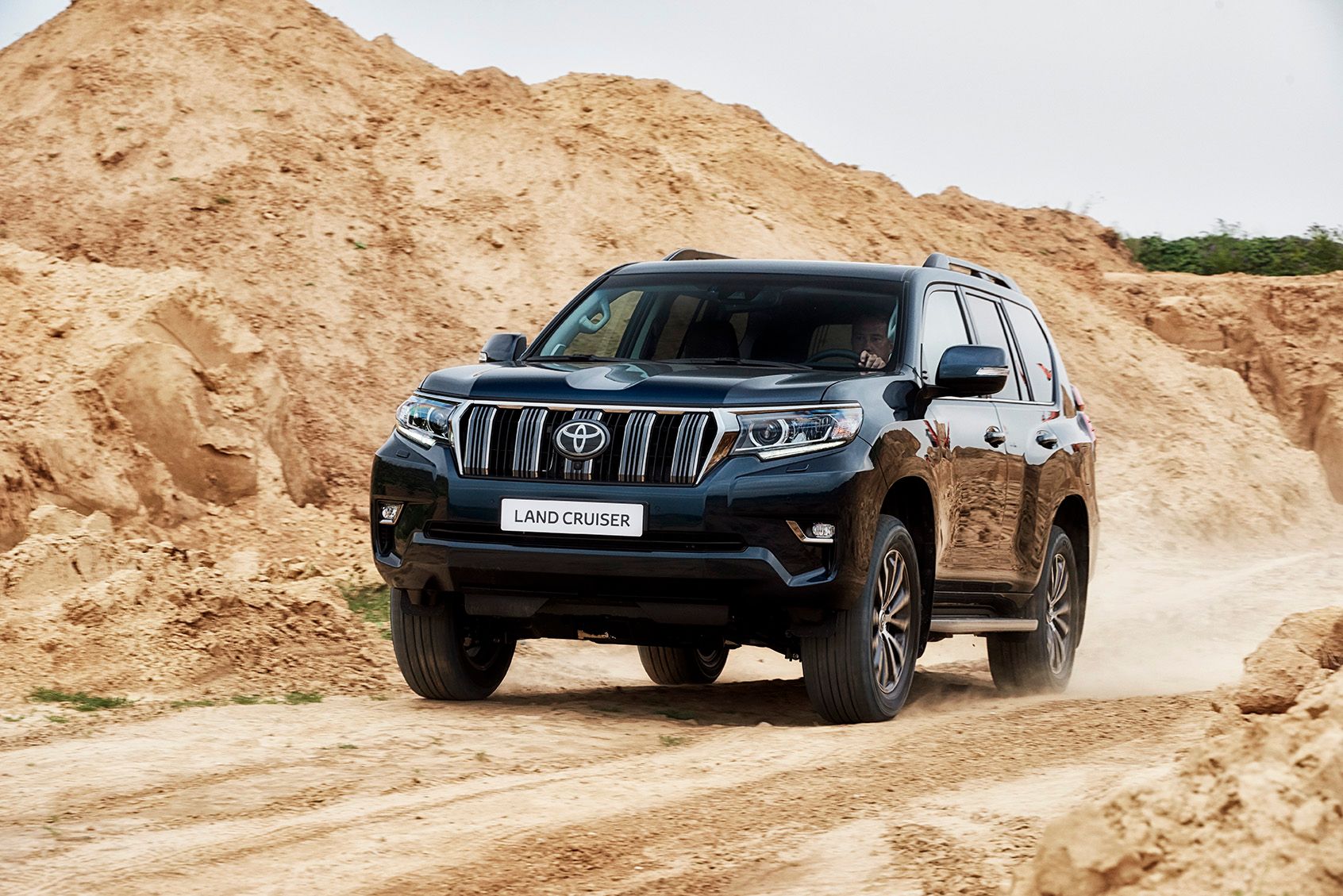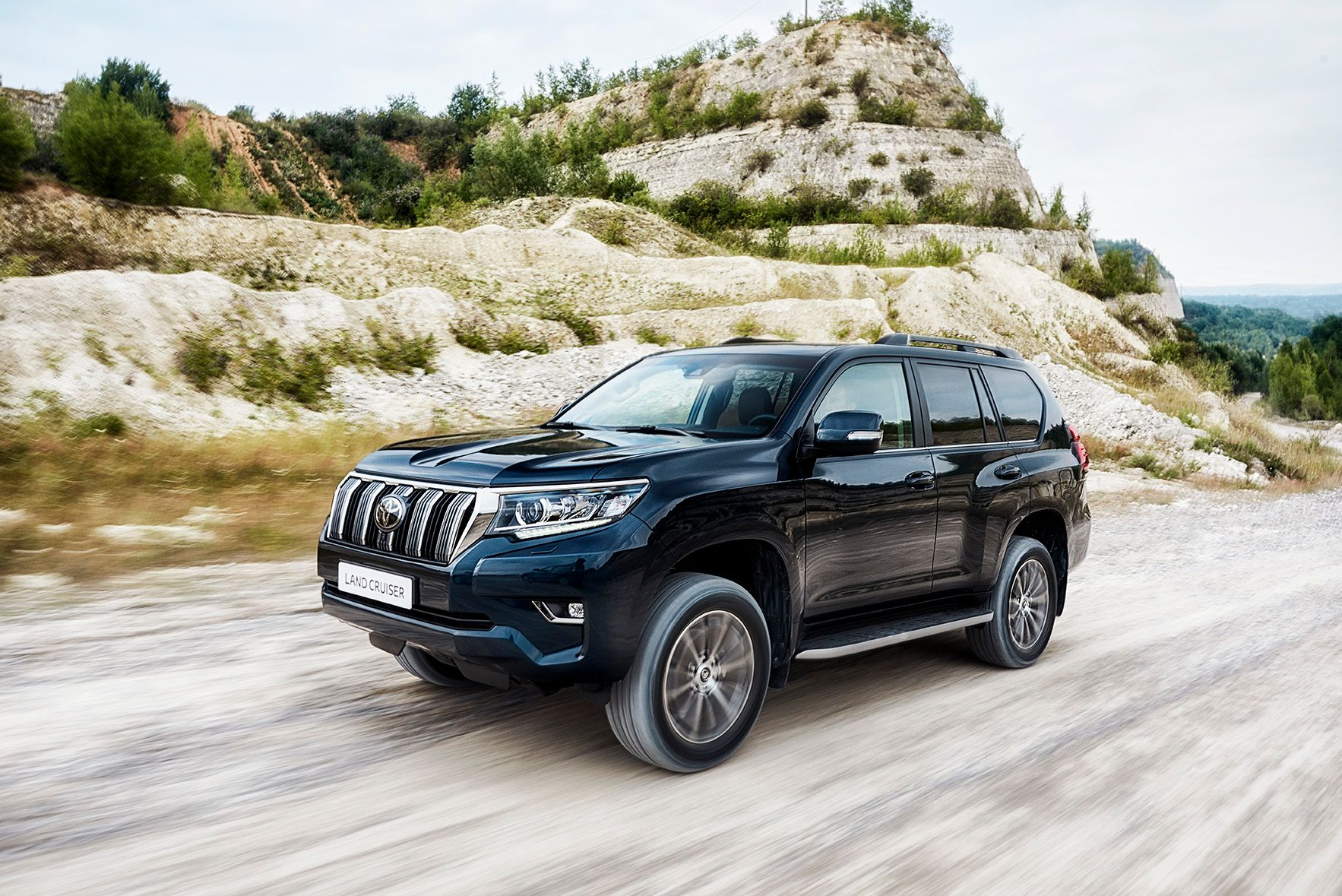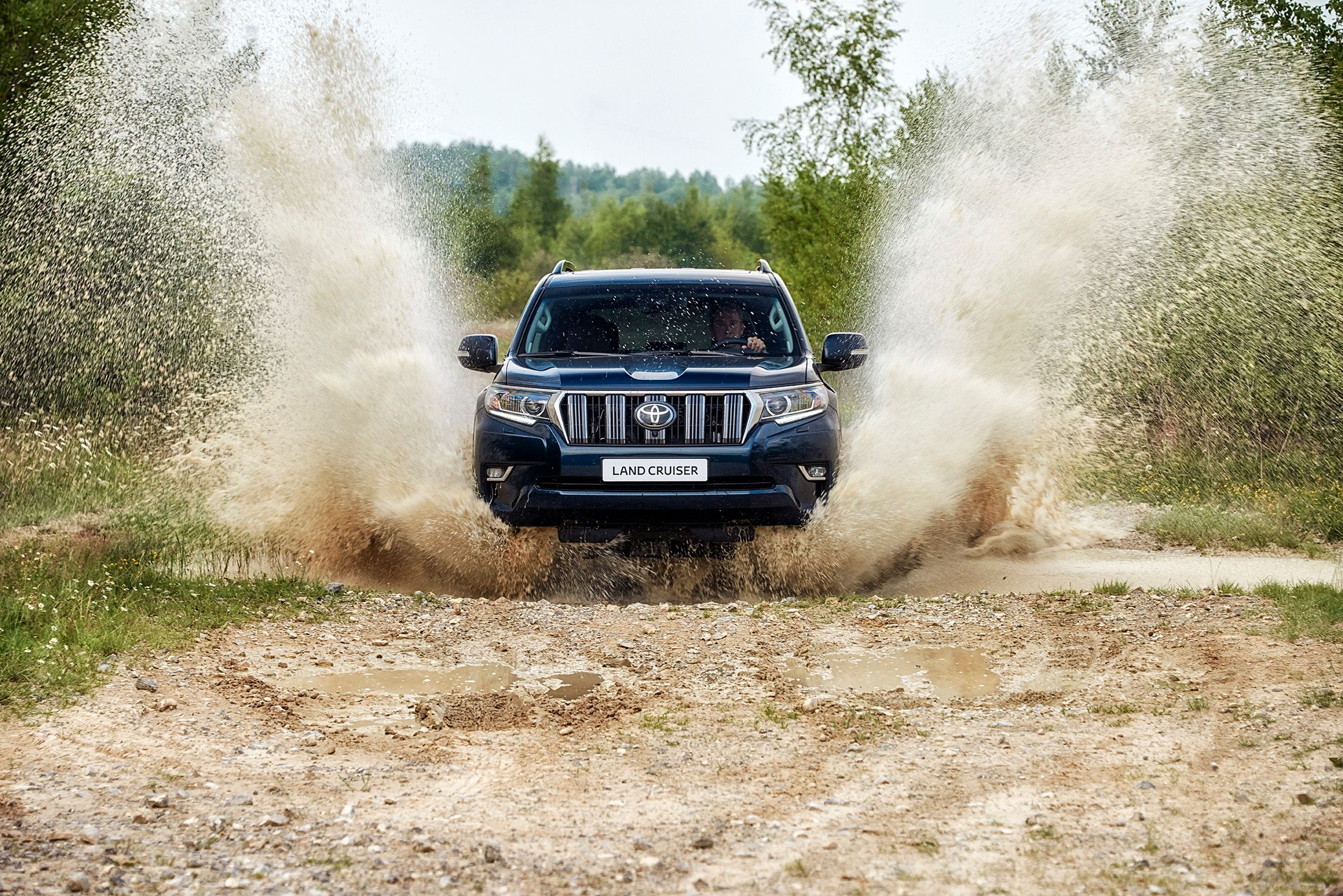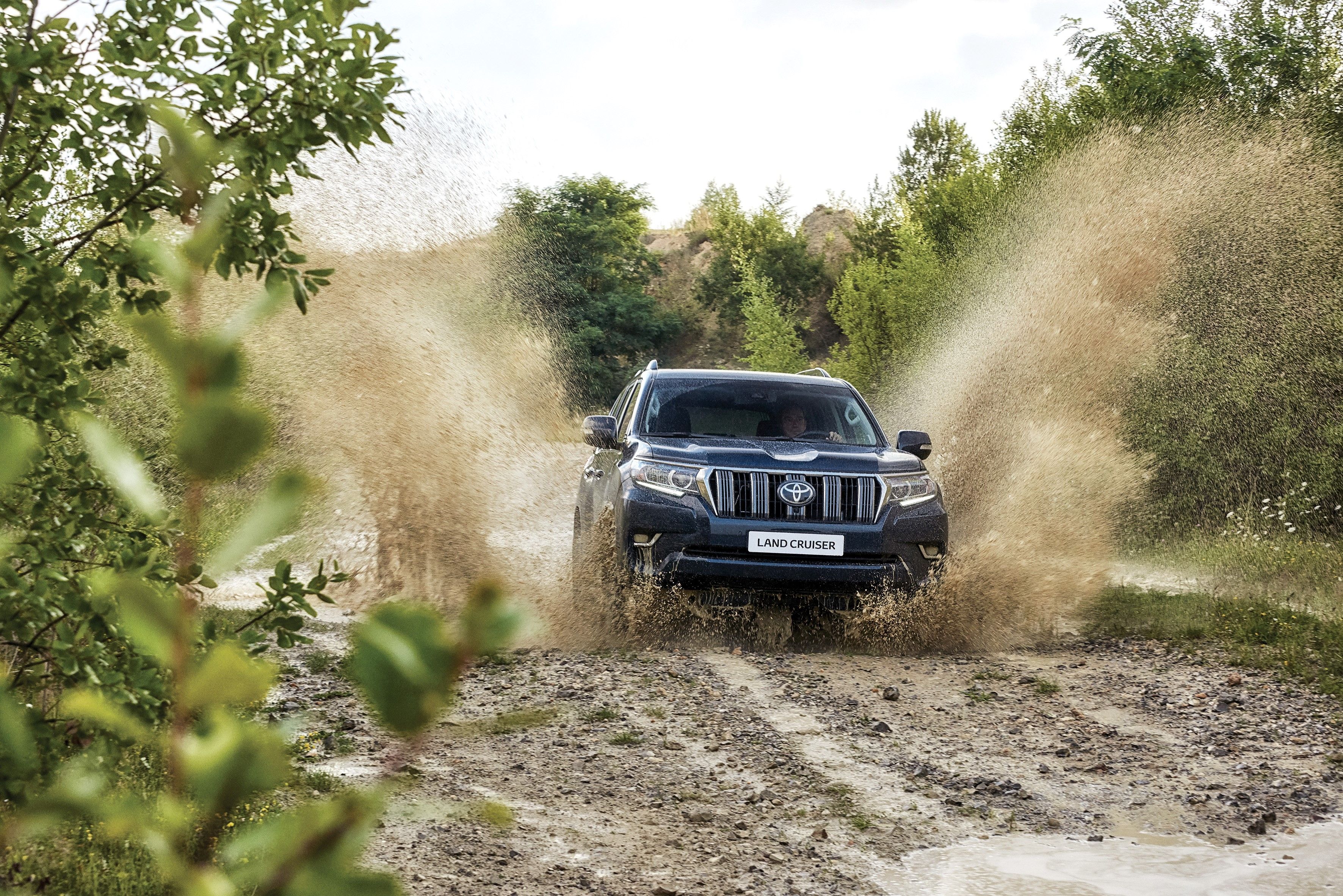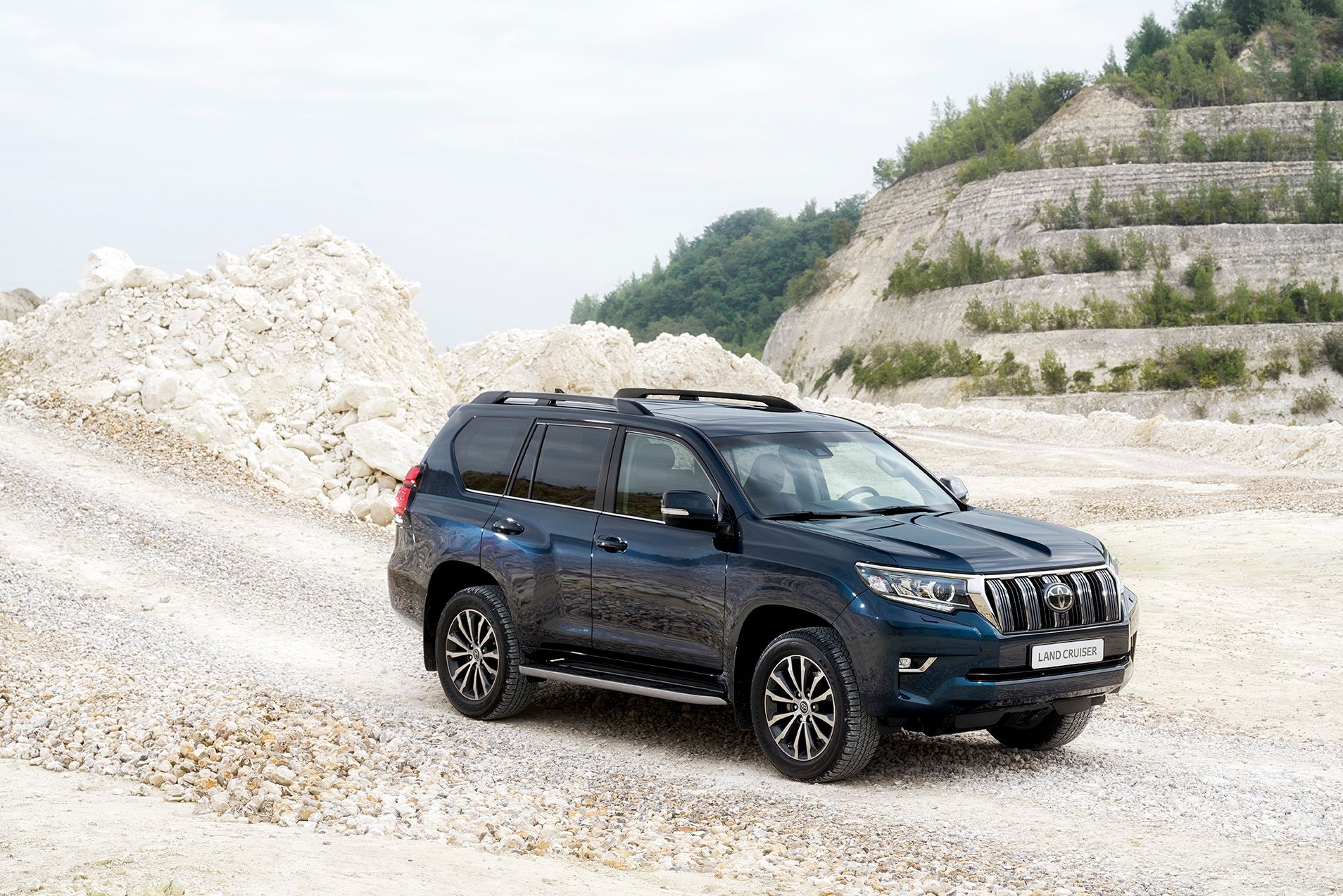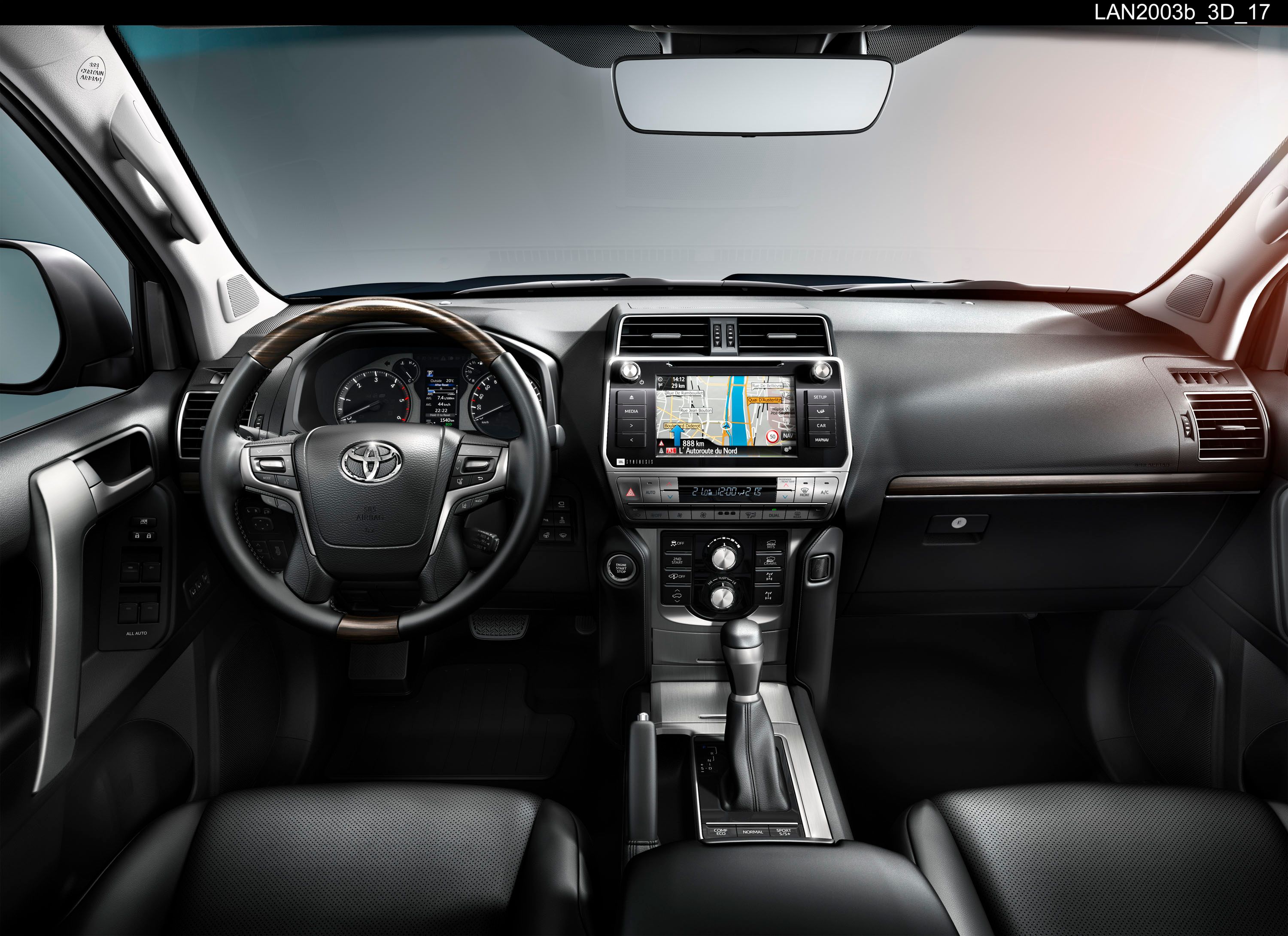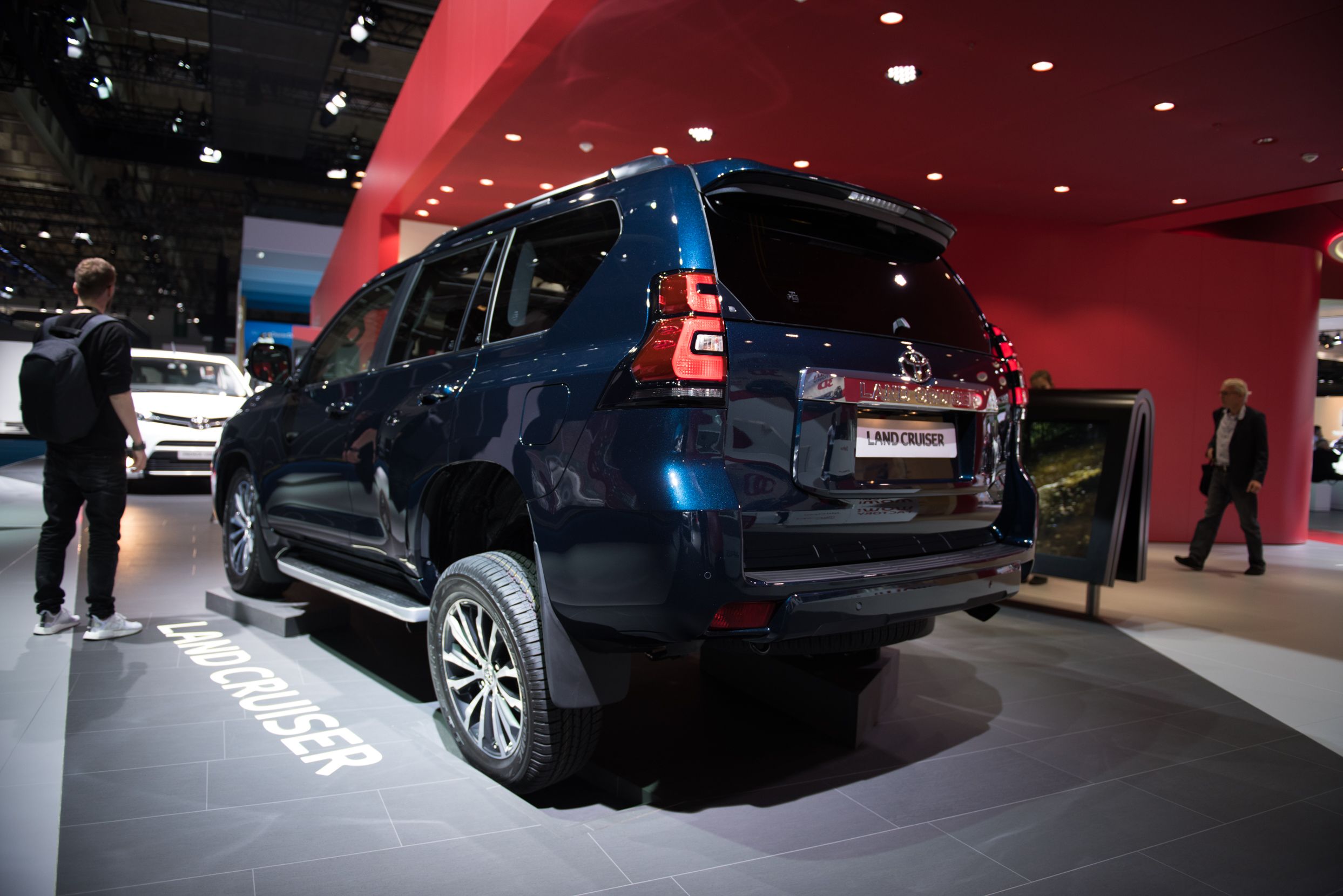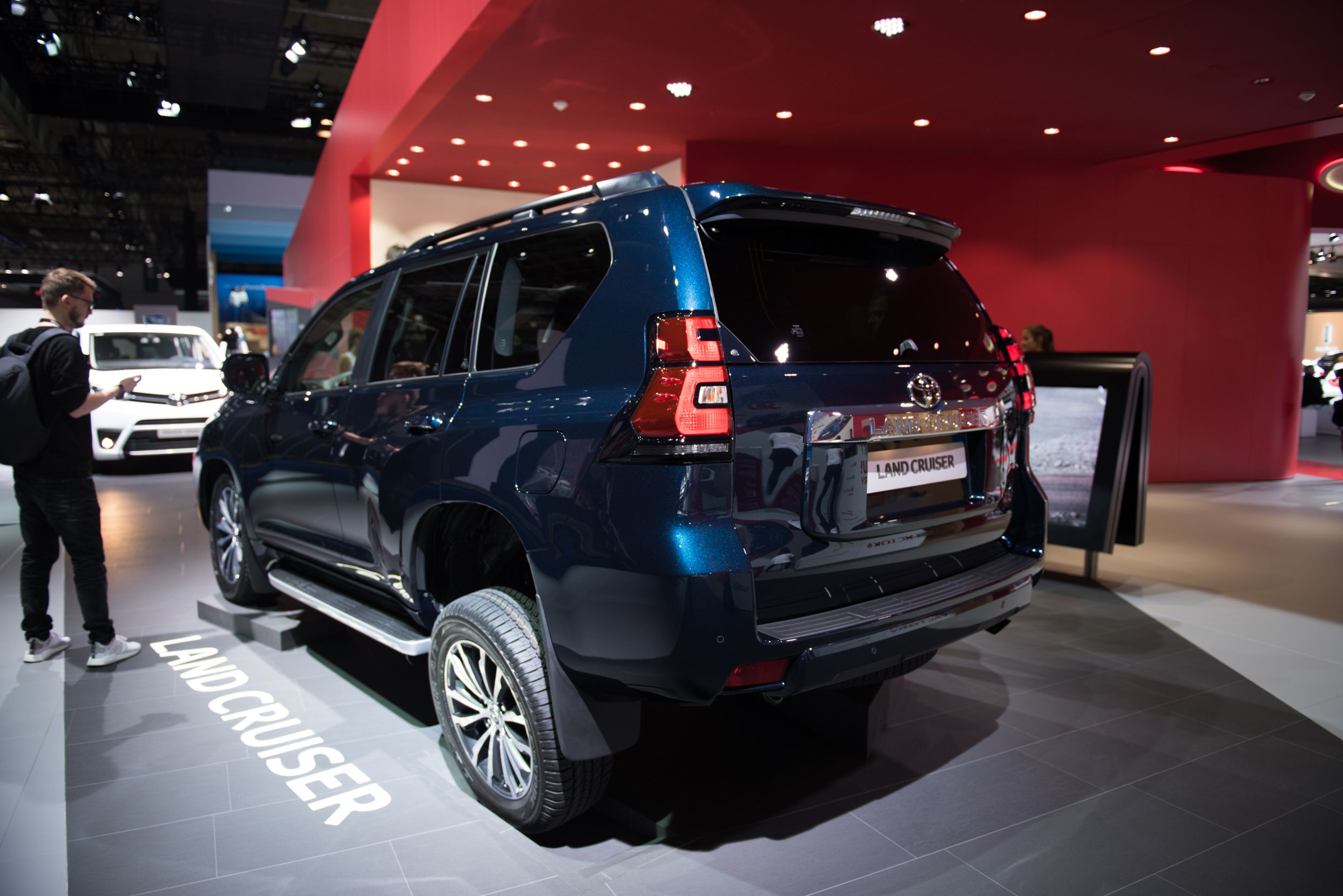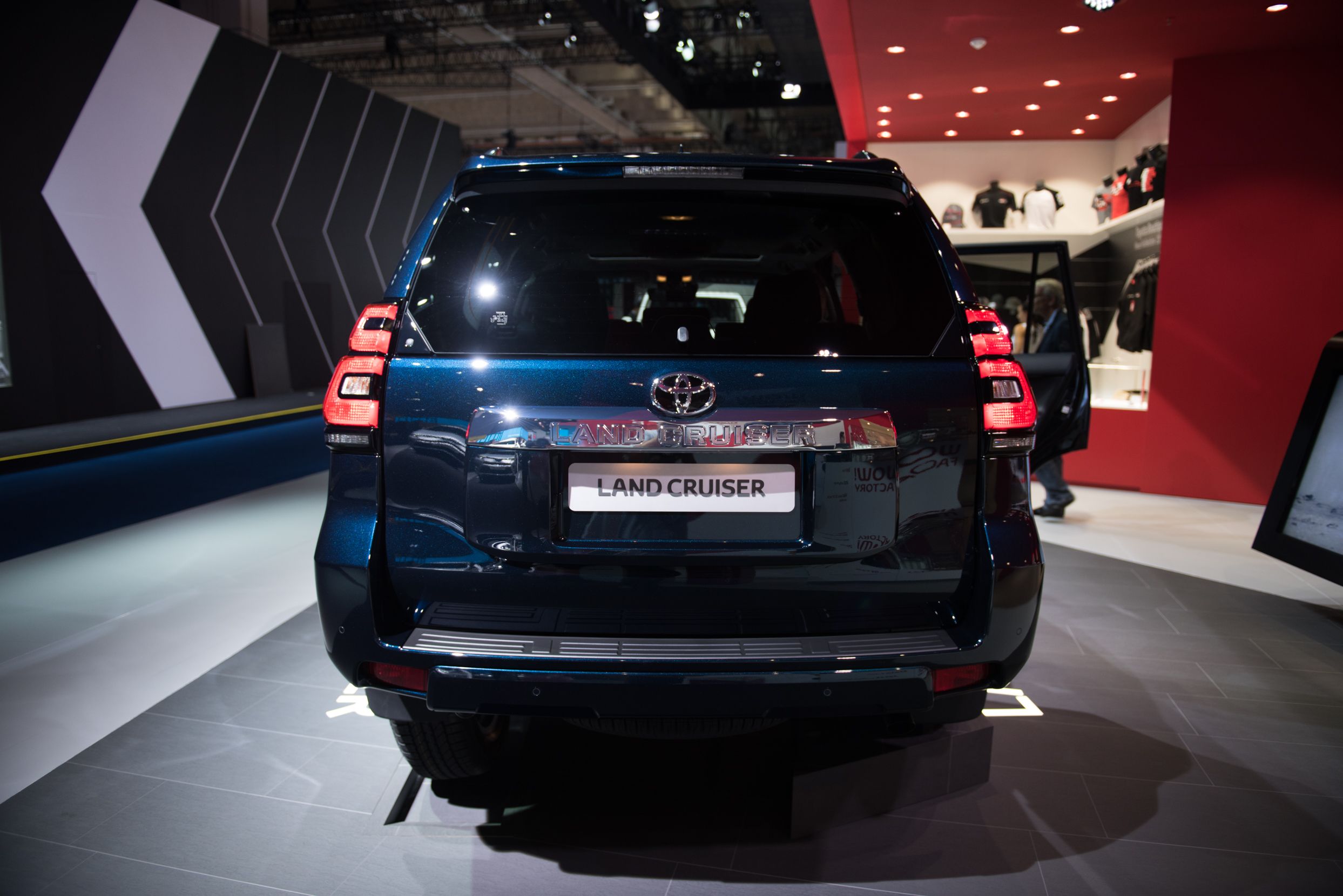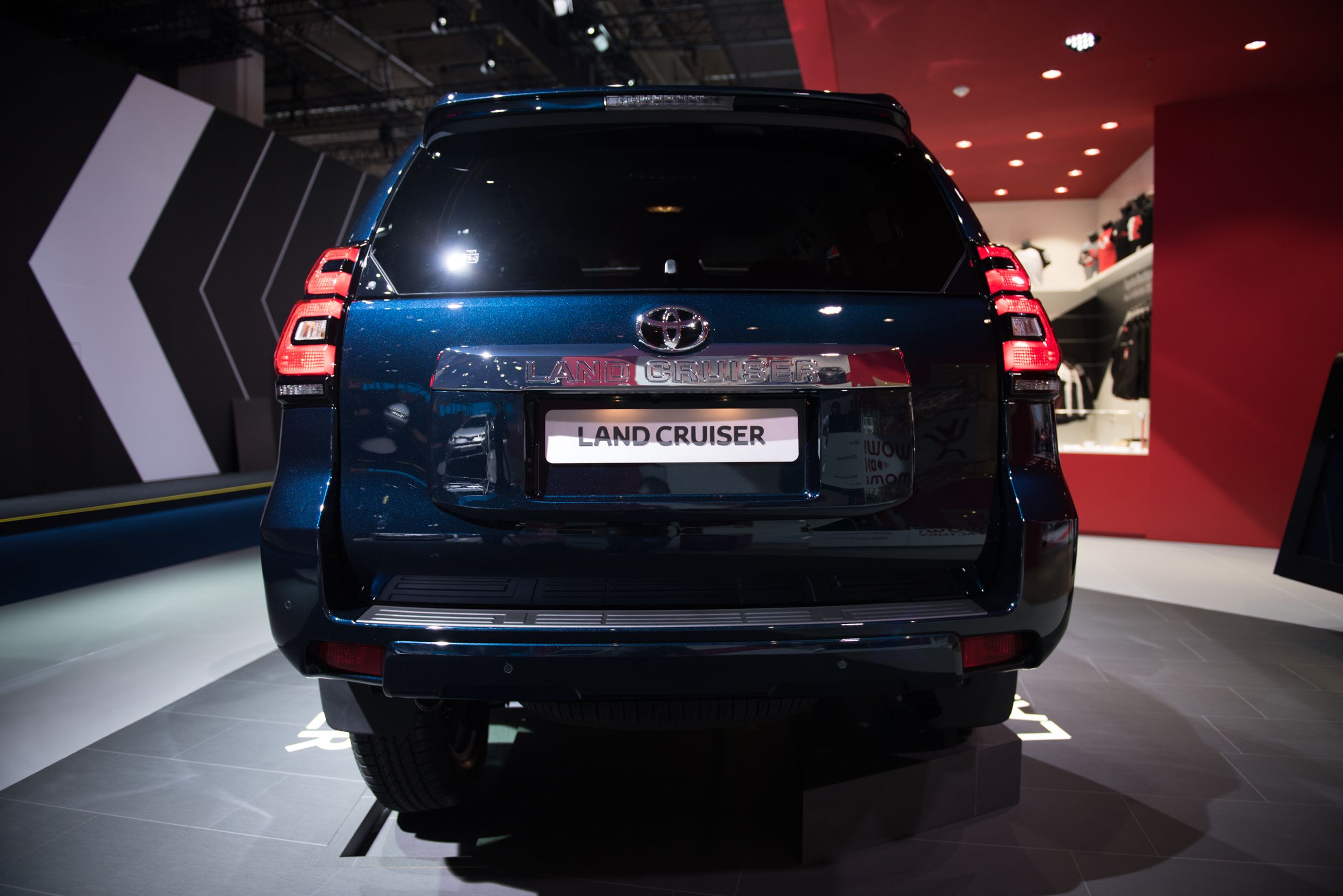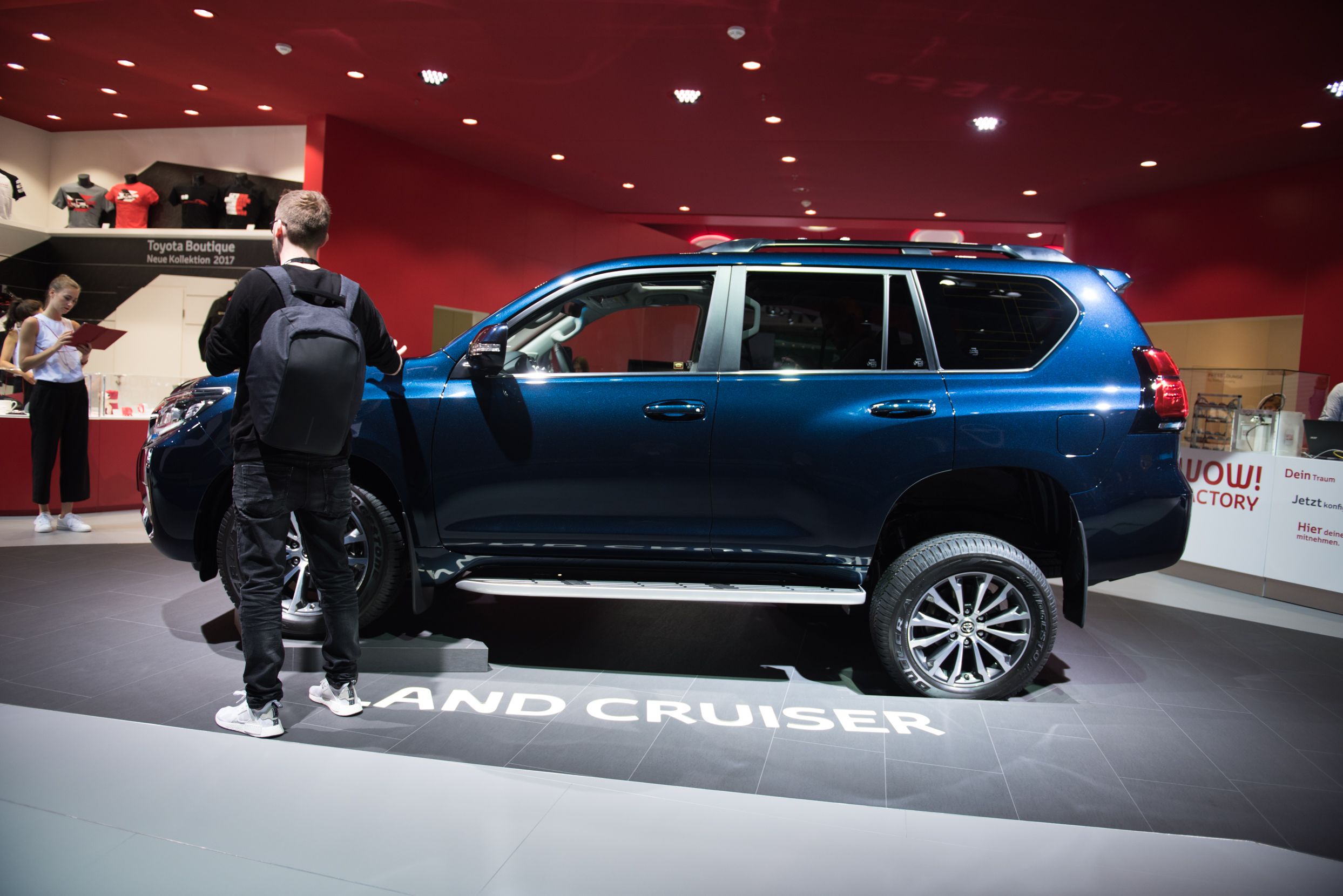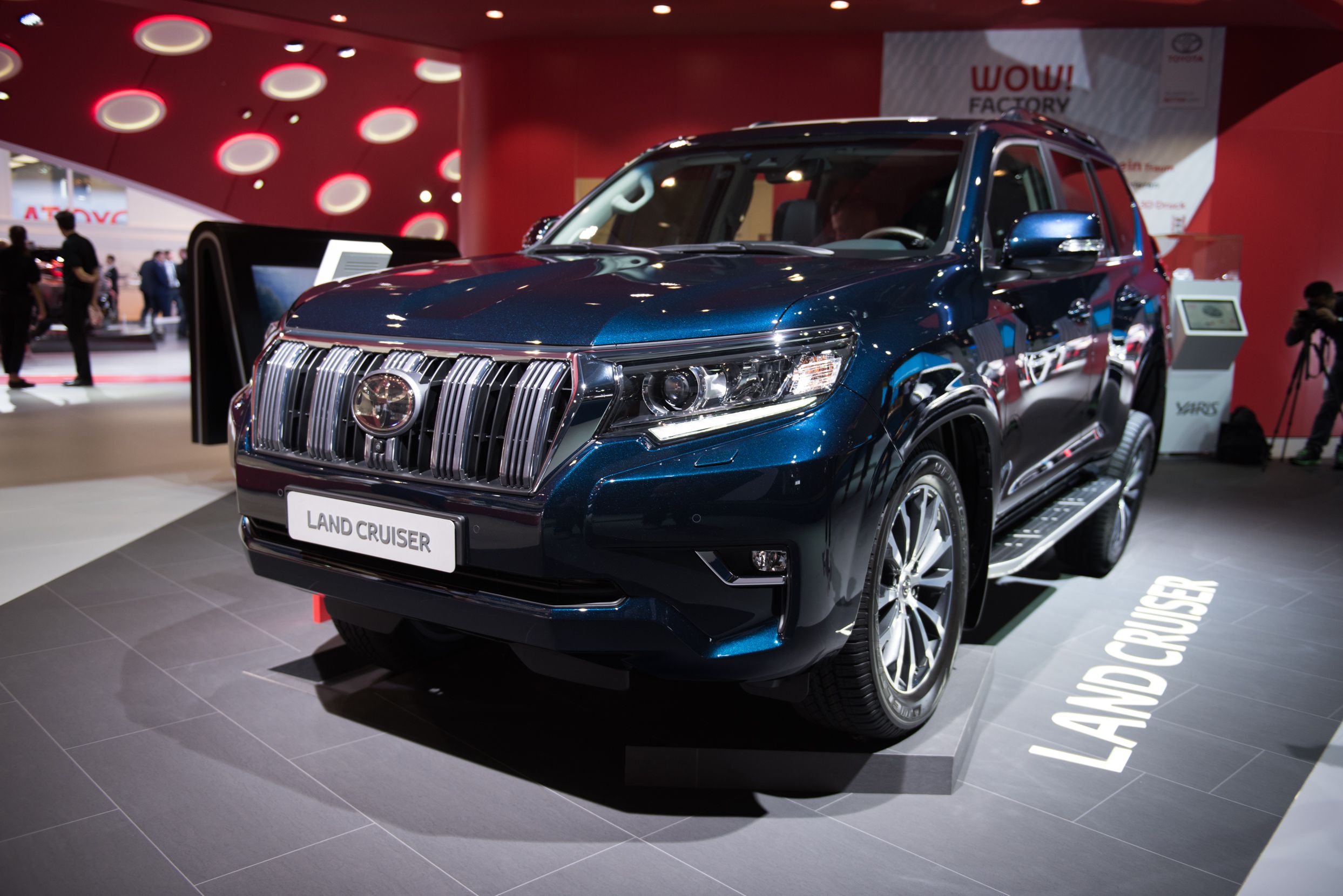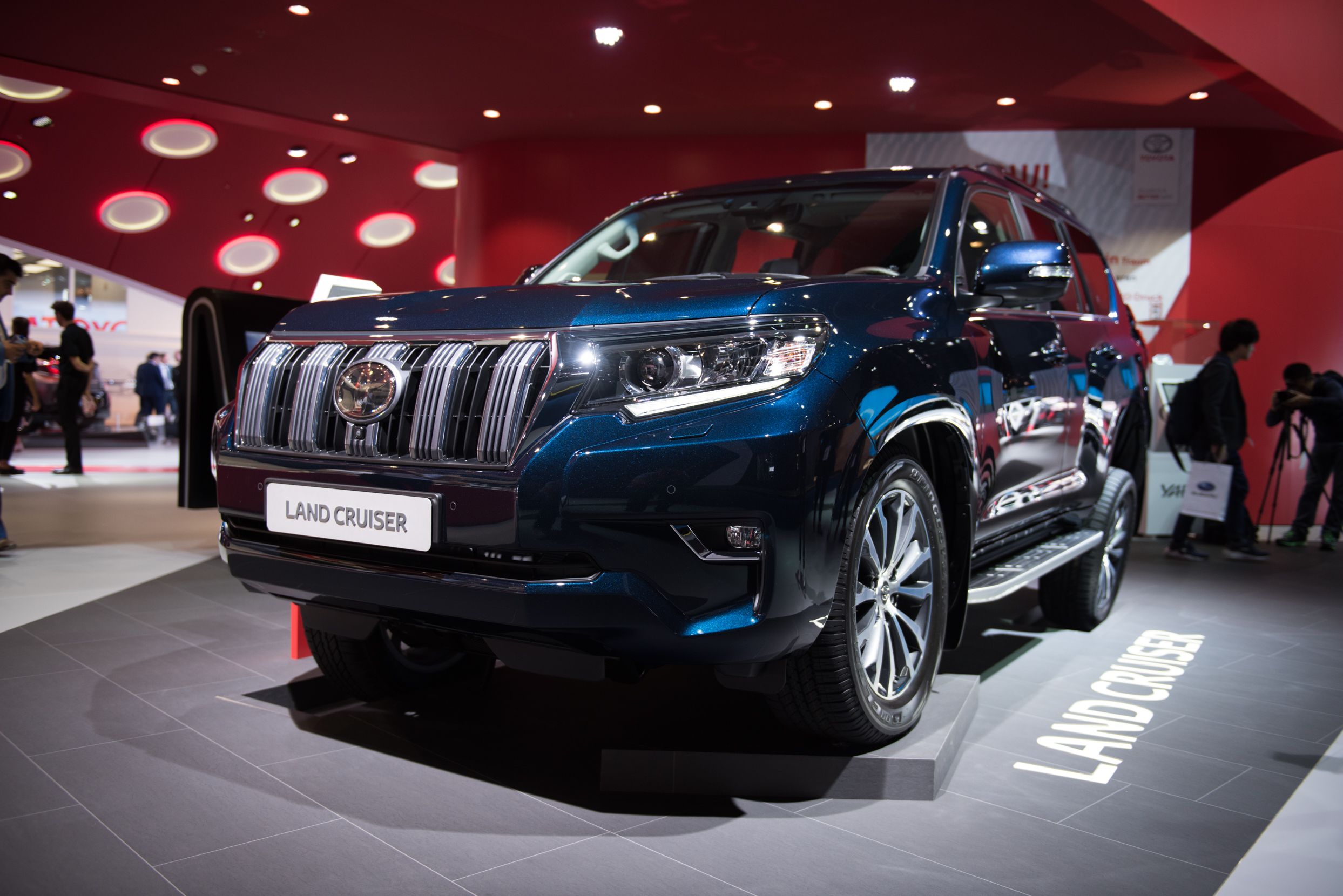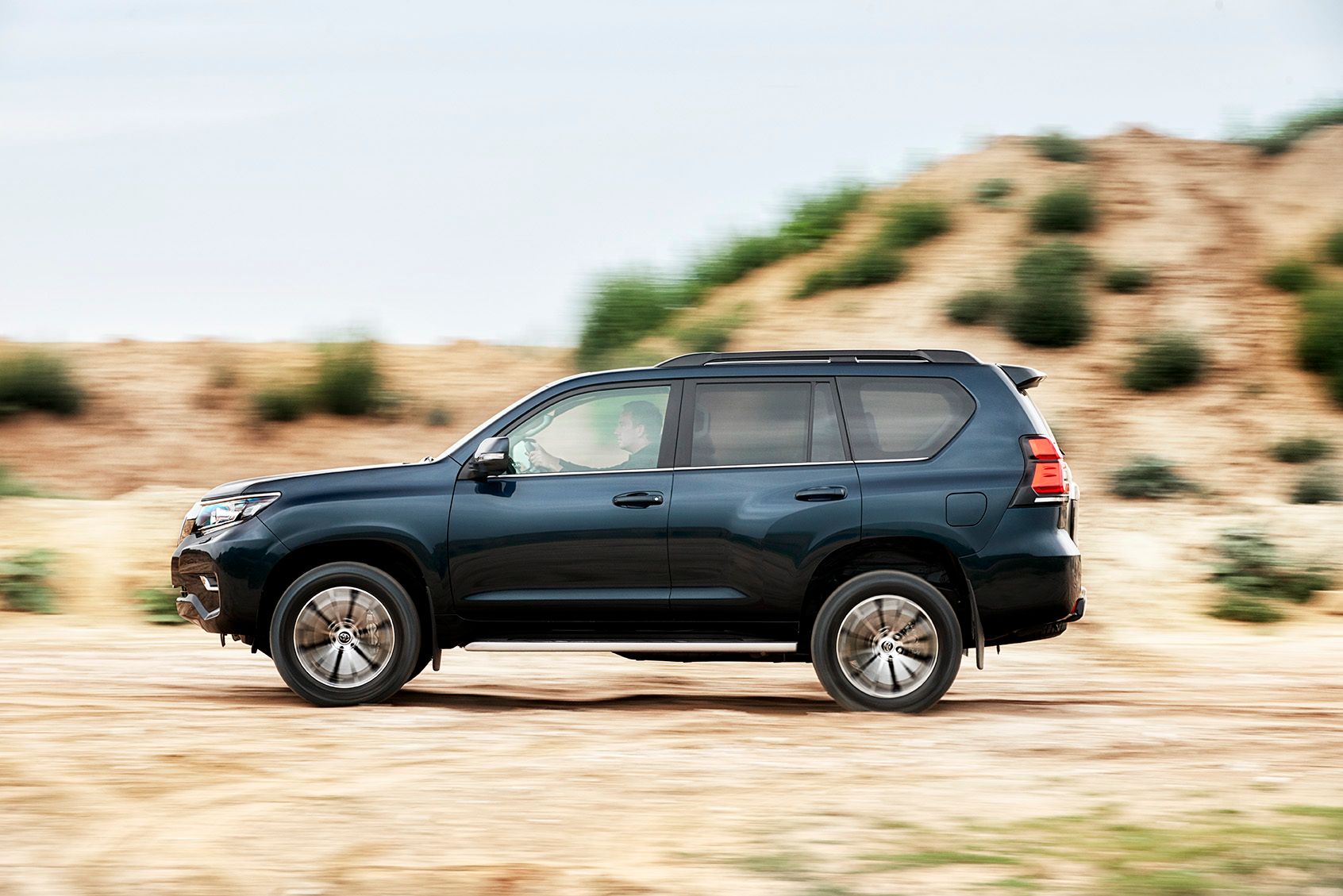The Toyota Land Cruiser is about as iconic as vehicles come, so it’s a big deal when something changes. For 2018 in global markets, the Land Cruiser is getting a few appearance upgrades and a redesigned dashboard – both in an effort to keep this go-anywhere, three-row SUV flying off showroom floors. Toyota debuted its updated Land Cruiser at the 2017 Frankfurt Motor Show ahead of its on-sale date later this year.
The Land Cruiser’s reputation is rooted in reliability and its rugged dependability in off-road situations, often far from civilization. It makes sense, then, that Toyota boasts about the SUV being “easy to maintain and repair” right in its press materials. You won’t find that in a Land Rover’s press kit. While easy trail repairs isn’t the Land Cruiser’s best selling point in North America where customers view it as a status symbol, many of the 190 countries place an extreme value on making a round trip when leaving the house. Of course, the 2018 Land Cruiser is more than just reliable transportation. It offers plenty of luxury and creature comforts, too. Let’s check out what changes Toyota has made for 2018. Perhaps some of these will even make it to the U.S.-spec Land Cruiser, as well.
Continue reading for more about the 2018 Toyota Land Cruiser.
2018 Toyota Land Cruiser
- Make: Array
- Model: 2018 Toyota Land Cruiser
- Engine/Motor: inline-4
- Horsepower: 128
- Torque: 332
- Transmission: six-speed automatic
- [do not use] Vehicle Model: Array
Exterior
Toyota has brought a handful of cosmetic updates to the Land Cruiser for 2018. Chief among them is the new front clip. It includes a new grille, reworked lower fascia, and new headlights. Now, Toyota isn’t changing stuff for that simple sake. Rather, these changes help improve the Land Cruiser’s abilities in the bush.
The grille and lower fascia, for example, are higher than before, helping the Land Cruiser’s water fording ability. The headlights are now mounted further inboard, keeping them safer from trail damage. Even the hood has a functional purpose to its design. That center crease helps give the driver a better view of the trail ahead. The same is true for the front fenders, which now have taller edges that help the driver know the width of the vehicle, allowing him to use every inch of trail. Of course, these physical features are supplemented by the Land Cruiser’s high-tech 360-degree camera system and Toyota’s new Multi-Terrain Monitor with its Under-Floor View, which renders a simulated image on the infotainment screen of the real-world obstacles ahead.
Of course, the front isn’t the only new sheet metal. The rear received some heavy massaging, with new taillights and a revised liftgate. Those lights are now oriented vertically, helping give the Land Cruiser more visual height rather than width, as the old, fatter taillights did. Gone is the wide swath of chrome, traded for a tasteful chrome piece just above the license plate.
What would a mid-cycle refresh be without some new wheels, too? Toyota offers choices between 17-, 18-, and 19-inch alloy wheels wrapped in street-biased tires that are actually not terrible in the dirt. Expedition leaders might want to swap them for a set of dedicated all-terrain or mud tires, though.
Interior
The Land Cruiser’s interior didn’t escape change, either. Toyota has rearranged the dashboard to better organize switches and buttons. In fact, things are placed into three categories: drivetrain, driving, and comfort. The reasoning is to help the driver find controls without having to search or take his eyes off the road.
New items include the driver’s gauge cluster, the infotainment screen, the top-mounted HVAC vents, the HVAC controls, and the prominently placed 4WD controls. As for the gauges, there is a new 4.2-inch TFT display for vehicle information and four analog gauges for the usual stuff like speed, fuel level, and engine rpm. A rather nice 8.0-inch infotainment screen now resides above the center stack, offering all the modern conveniences wrapped in Toyota’s Touch 2 with Go software. Luxury touches include leather seating, a leather-wrapped and wood-capped steering wheel, thick pads for elbows and knees, and things like heated seats and tri-zone climate controls.
The Land Cruiser might be a champ off the beaten path, but it’s not a small vehicle. It holds seven people in a 2+3+3 configuration. The third-row seats have a unique folding action unlike most SUVs Americans are used to. The 50/50-split bench actually folds against the walls, creating a flat load space without the seats submerging into the floor. The second row has 60/40 split and each side tumbles forward to rest against the front seatbacks. None of the rear chairs nestle into the floor. Still, the Land Cruiser offers 81.7 cubic feet of cargo volume with the rear seats folded away.
Drivetrain
Things remain the same behind the Land Cruiser’s new grille. The three familiar engines return: the 2.8-liter D-4D four-cylinder turbodiesel, the 2.7-liter gasoline four-cylinder, and the 4.0-liter gasoline V-6. However, Toyota decided to end the availability of the gasoline V-6 in Australia due to the D-4D’s massive 98.8-percent take-rate.
It’s no wonder the little 2.8-liter four-cylinder is so popular – it makes 128 horsepower and 332 pound-feet of torque when paired with the six-speed automatic transmission. Toyota does offer a six-speed manual, too, but that does cap the D-4D’s torque to only 309 pound-feet.
As for the 2.7-liter gasoline four-cylinder, it only makes 118 horsepower and 181 pound-feet of torque, making it the least-desirable engine option. The venerable 4.0-liter gasoline V-6 returns, too, with its same 180 horsepower and 281 pound-feet of torque. Of course, not all three engine options and transmission pairings will be available in all 190 counties the Land Cruiser is sold in. The 2.8-liter turbodiesel is the only choice in Australia and Western Europe. Eastern Europe and other markets will have access to the two gasoline mills.
The Full-Time 4WD System
Of course, a big part of the Land Cruiser is its full-time 4WD system. A Torsen limited-slip center differential splits power between the half-shaft axles up front and the solid axle out back. The differential offers both high and low range gears. In normal operation, torque is split 40/60 to the front and rear. Should a wheel start slipping, the system automatically routes power to the wheels with traction, giving the Land Cruiser a sure footing.
Working in conjunction with the mechanical 4WD system is Toyota’s CRAWL Control, A-TRAC, and Multi-Terrain Select systems. CRAWL control, as used on vehicles like the Tacoma and 4Runner, is like a low-speed cruise control. It allows the driver to set a constant speed under roughly 10 mph. The system then controls the throttle and brakes to maintain that speed over any terrain while the driver can concentrate on steering. The A-TRAC system, or Active Traction Control, uses individual brake inputs to control wheel spin while feathering throttle input from the driver’s right foot. Multi-Terrain Select offers driver-selectable settings like Mogul, Rock, Rock and Dirt, Loose Rock, and Mud and Sand. Together, along with Downhill Assist and Hill-Start Assist, these systems help keep the Land Cruiser moving regardless of the terrain.
Another interesting feature is Turn Assist. When in 4WD Low range, it allows the driver to individually lock the inside rear wheel, essentially making the Land Cruiser pivot on that point. Those who have operated a tractor with individual rear brakes will know the advantages locking the inside wheel gives to reducing the turning radius. In other words, Turn Assist makes the three-row Land Cruiser handle like a two-door Jeep Wrangler – but only at a slow crawl.
All these features are bolted to the Land Cruiser’s backbone – a ladder frame on which the body and suspension are bolded. Up front, the Land Cruiser uses an independent suspension system with MacPherson struts, while the rear suspension uses a multi-link and coil-spring setup to locate and damp the solid rear axle.
Pricing
Toyota did not release pricing at the 2017 Frankfurt Motor Show, but those details shouldn’t be too far from becoming official. As for the current Land Cruiser, it starts at $54,000 and can grow to around $86,000 in Australia. Here in the U.S., the Land Cruiser starts at $83,665 and goes up from there. About the only major option offered on the U.S.-spec Land Cruiser is the $2,220 rear seat entertainment package. As for the updated 2018 model, expect prices to rise slightly, but not over $500. We’ll update you when the information becomes available.
The Competition
Land Rover Range Rover
The Range Rover is a close rival to the Land Cruiser in terms of a pure icon symbol of luxurious off-roading. In it current form, the Range Rover is a modern, aluminum-intensive unibody with a sophisticated lineup of powertrains a full-time 4WD system, and a four-wheel independent suspension system with adjustable air ride.
Power comes from a trio of engine options starting with a supercharged 3.0-liter V-6 with 340 horsepower. For those wanting efficiency, Land Rover now has its 3.0-liter V-6 turbodiesel with 254 horsepower and 440 pound-feet of torque that gets an EPA-estimated 22 mpg city and 29 mpg highway. Those lusting after power will want the supercharged 5.0-liter V-8 with 510 horsepower and 461 pound-feet of torque. Regardless of choice, an eight-speed automatic does the shifting and the full-time 4WD system is standard. Ordering the Terrain Response 2 system is required for getting all the extra off-road goodies like the three locking differentials and low-range transfer case.
Prices for the Range Rover start at $85,650 and can grow well into the $100,000 range. Opting for the extended wheelbase or Autobiography editions will push the price even further north.
Read our full review on the Land Rover Range Rover.
Infiniti QX80
The QX80 is a relative newcomer to the game, but actually hides a secret. It’s based on the Nissan Armada, which is based on the Nissan Patrol – a hard-core SUV build for talking the deserts of the Middle East. Here in the U.S., the QX80 is an overgrown luxury barge not built to tackle the Rubicon trail, but rather Rodeo Drive. Overstated proportions and a leather-lined interior give the Infiniti a definite air of form over function.
Under the hood is a 5.6-liter gasoline V-8 with a respectable 400 horsepower and 413 pound-feet of torque. A seven-speed automatic does the shifting Unlike the other three-row SUVs here, the QX80 actually comes standard in RWD. Making the front tires turn with a full-time 4WD system adds another $3,100. Sadly, the Nissan Patrol’s rugged underpinnings have been softened here, tuned for a supple ride rather than crushing boulders.
Pricing starts at $89,000 and quickly edges toward that six-figure mark. Those not concerned with blazing down trails might enjoy the plushiness of the QX80, though the Land Rover will certainly give it a run for its money.
Read our full review on the Infiniti QX80.
Conclusion
The improvements to the Land Cruiser certainly help prepare it for entry into the next decade. However, as vehicles become more complicated and driven by fuel economy improvements, it’s great to see the Land Cruiser hold out against outlandish changes. Toyota has kept things (mostly) simple while still adopting all the necessary modern tech it takes to sell a vehicle today. Infotainment screens and fancy off-road modes aside, the Land Cruiser still embodies that timeless spirit of expedition and rugged dependability. Its new face and dashboard don’t subtract from that. Still, I’m definitely impressed with the updates. I’m also looking forward to seeing what updates will come to the U.S.-spec Land Cruiser and if Toyota will actually market the vehicle outside its apparent strategy of word-of-mouth from loyal repeat Land Cruiser customers.
References
Toyota Land Cruiser
Read our full review on the previous generation Toyota Land Cruiser.
Read all the latest news from Toyota

